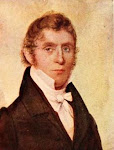 When I first found and started to read the early 19th Century abolitionist newspapers of Benjamin Lundy ("The Genuis Of Universal Emancipation"), and William Lloyd Garrison's "The Abolitionist", I was struck by how much these 1820s and 1830s weekly and monthly journals felt like our modern-day blogs.
When I first found and started to read the early 19th Century abolitionist newspapers of Benjamin Lundy ("The Genuis Of Universal Emancipation"), and William Lloyd Garrison's "The Abolitionist", I was struck by how much these 1820s and 1830s weekly and monthly journals felt like our modern-day blogs.The formats are remarkably similar: Lundy and Garrison collected stories from regional (and occasionally, international) newspapers that related to their journals' themes, acting more as editors than reporters, much as bloggers do today (It was part of the "rules of the game" that editors shared their newspapers with each other through mailed subscriptions, and that proper credit would be given when one editor would reprint a story originally appearing in another's journal, exactly how linked stories are handled today); readers wrote in with their comments and observations, and their letters in turn were commented upon by the editor; meetings were "live-blogged" by having their minutes published in subsequent journal entries...
It seems the urge to blog on a theme of personal interest is "something old made new again".
I see that I'm not the first to make this observation; I'm in the middle of reading Merton L. Dillon's 1974 book, "Abolitionists: The Growth Of A Dissenting Minority", and while searching this morning for more information on the author, I came across this 2005 exchange between Professor Dillon and a former student of his, on the amazing resemblance between abolitionist journals and blogs.
Dillon compares the work of early abolionist writers to their modern-day counterparts, and perceptively concludes on a hopeful note that hadn't occured to me:
The problem, then, in an age lacking popular print or other conduits of information, was how to reach like-minded people. How can such people find each other? How can random and inchoate ideas be gathered from these sympathetic but disparate people and molded into an acceptable, rationally consistent program? Interchange of thought must be the process. What shall be the agency?
Beginning around 1820 small, shoestring newspapers began the process. [Benjamin] Lundy's [The Genius of Universal] Emancipation was one of the first and most long-lasting. Lundy sent his paper where he thought it might be welcomed. He printed exposes of the slave systen and proposed remedies. He invited readers to contribute their ideas. Later, [William Lloyd] Garrison did the same. The remedies were as varied as the critiques.
It took a while before antislavery advocates found each other and developed something like a community. It took still longer for them to forge a program. It is not ungenerous to conclude that, despite all their writing, all their speaking, all their conferring, they never were able to set forth a program for abolitionism that all opponents of slavery found acceptable, but they did create a society or community.
...
How do people find each other? Bloggers in quite systematic and lightning-speed fashion are taking advantage of the opportunities technology has given them to speed and share ideas and, potentially, to create societies all with a facility Abolitionists could not have dreamed of.

No comments:
Post a Comment